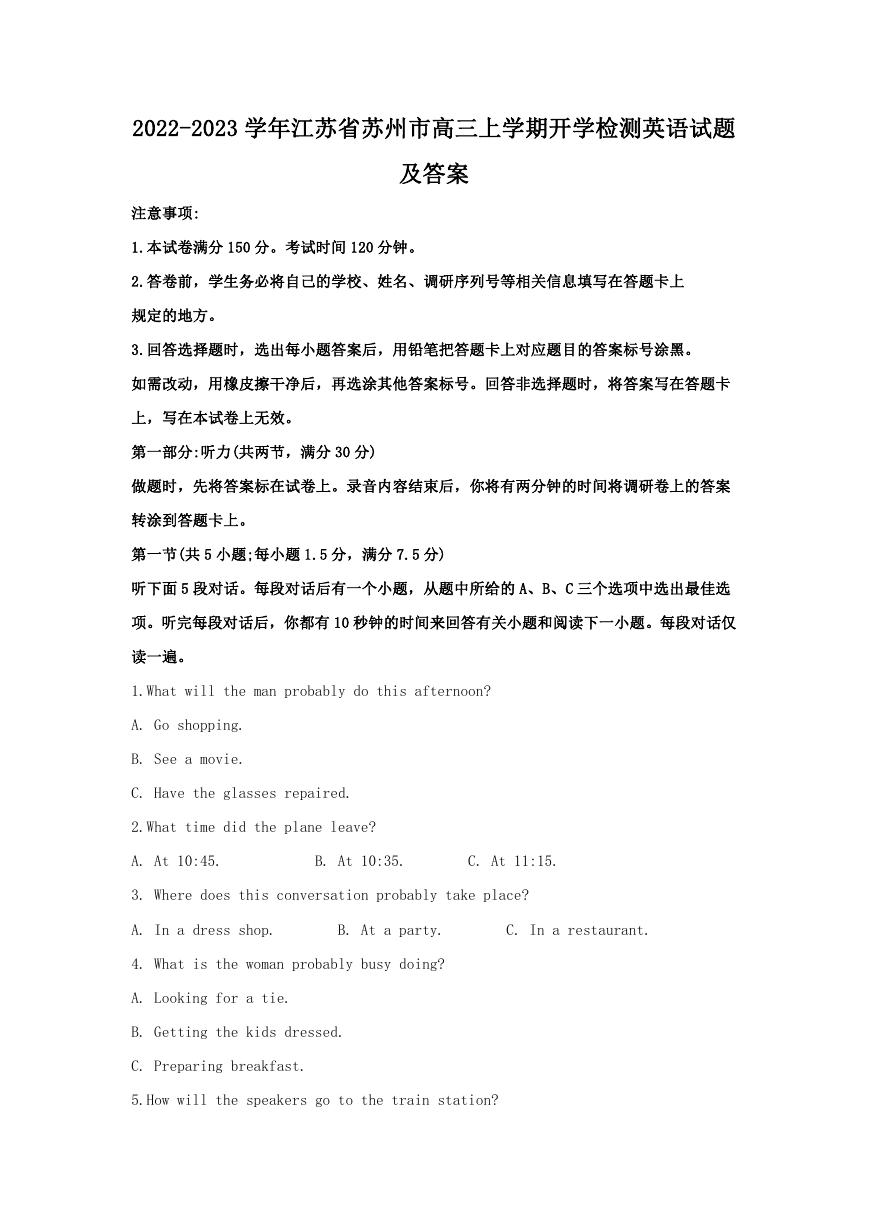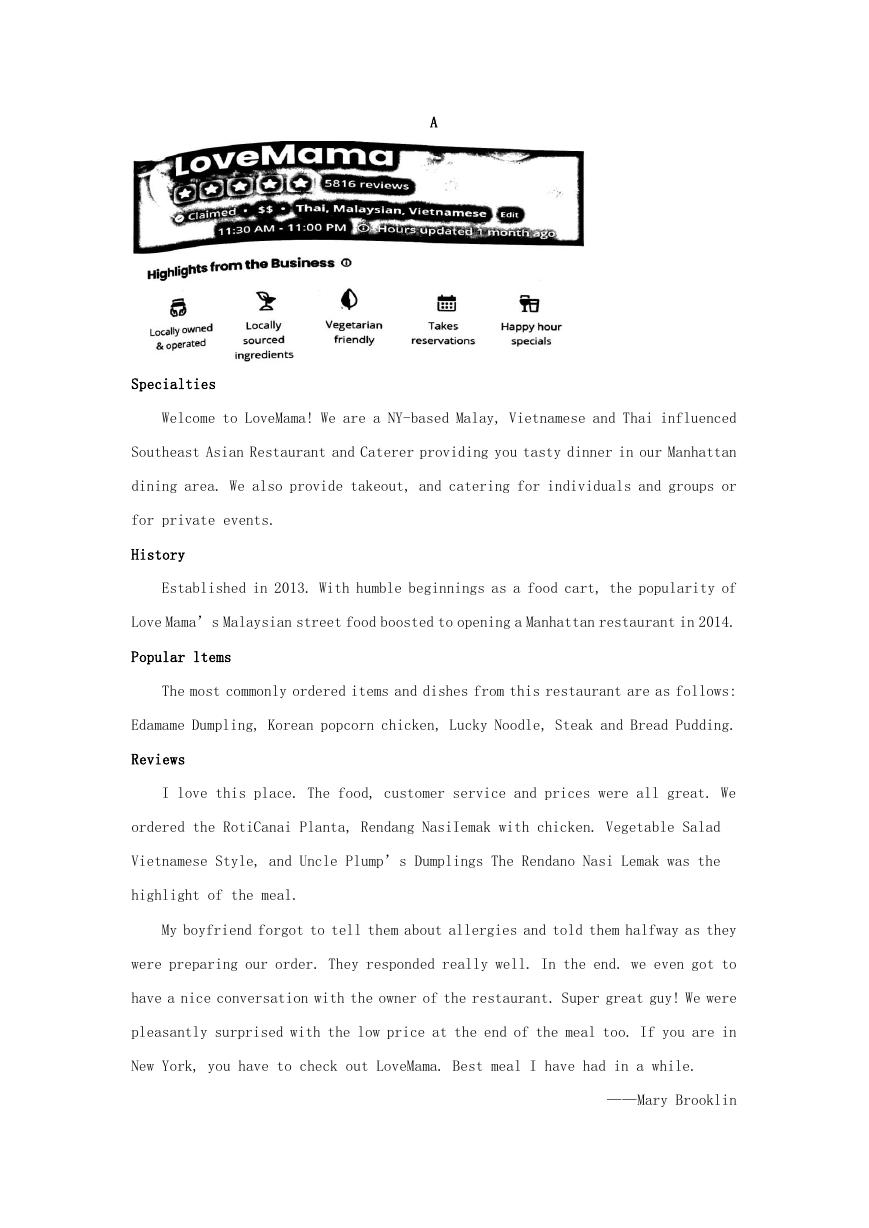2022-2023 学年江苏省苏州市高三上学期开学检测英语试题
及答案
注意事项:
1.本试卷满分 150 分。考试时间 120 分钟。
2.答卷前,学生务必将自己的学校、姓名、调研序列号等相关信息填写在答题卡上
规定的地方。
3.回答选择题时,选出每小题答案后,用铅笔把答题卡上对应题目的答案标号涂黑。
如需改动,用橡皮擦干净后,再选涂其他答案标号。回答非选择题时,将答案写在答题卡
上,写在本试卷上无效。
第一部分:听力(共两节,满分 30 分)
做题时,先将答案标在试卷上。录音内容结束后,你将有两分钟的时间将调研卷上的答案
转涂到答题卡上。
第一节(共 5 小题;每小题 1.5 分,满分 7.5 分)
听下面 5 段对话。每段对话后有一个小题,从题中所给的 A、B、C 三个选项中选出最佳选
项。听完每段对话后,你都有 10 秒钟的时间来回答有关小题和阅读下一小题。每段对话仅
读一遍。
1.What will the man probably do this afternoon?
A. Go shopping.
B. See a movie.
C. Have the glasses repaired.
2.What time did the plane leave?
A. At 10:45.
B. At 10:35.
C. At 11:15.
3. Where does this conversation probably take place?
A. In a dress shop.
B. At a party.
C. In a restaurant.
4. What is the woman probably busy doing?
A. Looking for a tie.
B. Getting the kids dressed.
C. Preparing breakfast.
5.How will the speakers go to the train station?
�
A. By bicycle.
B. By taxi.
C. By underground.
第二节(共 15 小题;每小题 1.5 分,满分 22.5 分)
听下面 5 段对话或独白。每段对话或独白后有几个小题,从题中所给的 A、B、C 三个选项
中选出最佳选项。听每段对话或独白前,你将有时间阅读各个小题,每小题 5 秒钟;听完
后各小题将给出 5 秒钟的作答时间。每段对话或独白读两遍。
听第 6 段材料,回答 6、7 题。
6. What does the boy want to do?
A. Walk further.
B. Have a rest.
C. Go faster.
7. What does the boy think of doing exercise?
A. It is exciting.
B. It is painful.
C. It is fun.
听第 7 段材料,回答第 8 至 10 题。
8. What does the woman probably do at night?
A. Read books.
B. Watch TV.
C. Go swimming.
9. What does the man think of the woman's nightlife?
A. Boring.
B. Amazing.
C. Exciting.
10. Why does the woman prefer not having a TV?
A. She thinks it's a waste of time.
B. She doesn't have a favorite show.
C. She wants to be different from her friends.
听第 8 段材料,回答第 11 至 13 题。
11. What are the speakers talking about?
A.A driving test.
B.A car accident.
C.A new examiner.
12. Who was ill?
A. Jackie.
B. Peter.
C. Ron.
13. What probably happened to the man in the end?
A. He got a ticket.
B. He hit a tree.
C. He ran over an old woman.
听第 9 段材料,回答第 14 至 17 题。
14. What is the first illegal item found in the man's bag?
�
A.A lighter.
B.A pocket knife.
C.A bottle of water.
15. Why is the man carrying a lighter?
A. He enjoys smoking cigarettes.
B. He is worried about his safety.
C. He forgot to take it out of his bag.
16.From whom did the man get the knife?
A.A close friend.
B.A stranger.
C.A relative.
17.Why doesn't the man know the airline's rules?
A. He didn't see the sign. .
B. He didn't read the sign through.
C. The sign was written in Chinese.
听第 10 段材料,回答第 18 至 20 题。
18. What is the speaker probably doing?
A. Introducing the rules of the college.
B. Running for the student representative.
C. Offering advice on improving the college services.
19.What will the speaker do to improve the housing in the college?
A. Help more students get housing.
B. Ask the college authorities for advice.
C. Have a proper housing system set up.
20. Why does the speaker want to invite some guests to the college?
A. To enrich students' daily life.
B. To help students know the outside world.
C. To get more examples for students to follow.
第二部分阅读理解(共两节,满分 50 分)
第一节(共 15 小题;每小题 2.5 分,满分 37.5 分)
阅读下列短文,从每题所给的四个选项(A、B、C 和 D)中,选出最佳选项。
�
A
Specialties
Welcome to LoveMama! We are a NY-based Malay, Vietnamese and Thai influenced
Southeast Asian Restaurant and Caterer providing you tasty dinner in our Manhattan
dining area. We also provide takeout, and catering for individuals and groups or
for private events.
History
Established in 2013. With humble beginnings as a food cart, the popularity of
Love Mama’s Malaysian street food boosted to opening a Manhattan restaurant in 2014.
Popular ltems
The most commonly ordered items and dishes from this restaurant are as follows:
Edamame Dumpling, Korean popcorn chicken, Lucky Noodle, Steak and Bread Pudding.
Reviews
I love this place. The food, customer service and prices were all great. We
ordered the RotiCanai Planta, Rendang NasiIemak with chicken. Vegetable Salad
Vietnamese Style, and Uncle Plump’s Dumplings The Rendano Nasi Lemak was the
highlight of the meal.
My boyfriend forgot to tell them about allergies and told them halfway as they
were preparing our order. They responded really well. In the end. we even got to
have a nice conversation with the owner of the restaurant. Super great guy! We were
pleasantly surprised with the low price at the end of the meal too. If you are in
New York, you have to check out LoveMama. Best meal I have had in a while.
——Mary Brooklin
�
Stopped by here for Valentine’s Day and we were not disappointed. We got 3
different dishes all from the Malaysian portion of the menu as none of us had ever
had Malaysian food. The service was fast but not supper attentive, which we didn’
t mind at all. For $20 each with tip and feeling full and happy, this is a spot I’
d definitely recommend!
——Peter Anderson
1. Where is the LoveMama restaurant?
A. In Thailand.
B. In Malaysia.
C. In Vietnam.
D. In
America.
2. What is special about this restaurant?
A. It can’t provide takeout orders.
B. It has customer-friendly business strategies.
C. It operates on a first-come-first-served basis.
D. It is state-owned and runs around the clock.
3. How do Mary and Peter find this restaurant?
A. Disappointing.
B. Cost-effective.
C. Time-honored.
D.
Average.
【答案】1. D
2. B
3. B
【解析】
【导语】这是一篇应用文。本篇文章主要讲述了 LoveMama 餐厅的起源、特色菜肴、餐厅亮
点以及服务态度等方面。
【1 题详解】
细节理解题。根据 Specialties 部分中“We are a NY-based Malay, Vietnamese and Thai
influenced Southeast Asian Restaurant and Caterer providing you tasty dinner in our
Manhattan dining area.(我们是一家总部位于纽约的马来、越南和泰国风味的东南亚餐厅
和餐饮供应商,在我们的曼哈顿用餐区为您提供美味的晚餐)”可知,该餐厅位于美国。故
选 D。
【2 题详解】
细节理解题。根据 Highlights from the Business 部分中“Vegetarian friendly(对素食
者友好)”以及其它四小点,可知该餐厅采取对顾客友好的策略,故选 B。
�
【3 题详解】
细节理解题。根据倒数第二段中“We were pleasantly surprised with the low price at
the end of the meal too.(晚餐结束时的低价也让我们感到惊喜)”以及最后一段中“For $20
each with tip and feeling full and happy, this is a spot I’d definitely recommend!(每
人 20 美元,外加小费,吃饱了还很开心,这是我绝对推荐的地方!)”可知,该餐厅性价比
很高。故选 B。
B
Figure skating, speed skating, and ice hockey can all trace their beginnings
to early civilizations that fastened animal bones to their feet to skate on ice,
according to A Dictionary of British History. Bone runners found in Switzerland date
as far back as 3000 B.C. and there is also evidence of ice skating in Scandinavia
in the Middle Ages.
Modern skating likely got its start in the Netherlands, where it was considered
a national recreation in the early 17th century, when nobles skated on frozen canals
for fun. Wealthy Europeans picked up the sport while visiting the Netherlands, and
British royals soon brought skating back to England in the late 1600s. When the Thames
froze over in 1683, skating was among the many recreations at London’s famous winter
fair on the ice, which King Charles II attended.
At the end of the 18th century, American ballet dancer Jackson Haines transformed
the sport into what is now known as figure skating by introducing elements of ballet
to the ice. According to the Dictionary of American History, Haines skated in bear
and ballet costumes and toured with exhibitions across Europe, where he was most
admired in Vienna, Austria.
Ice skating evolved into other sports, including speed skating and ice hockey.
Speed skating has been around as early as Dutch people dared to race on their skates,
but hockey developed in 19th century Canada as an icy version of field hockey. Both
were well-established by the 1900s, so they were on the list in the first Winter
Olympics.
Since the 1900s, different ice skating clubs have been founded around the Western
�
world. As interest grew, the clubs’ membership increased over the next 50 years.
By the end of 20thcentury, ice skating was so widespread that it was one of the few
recreations enjoyed by almost every westerner.
4. Which of the following is the oldest sport according to the text?
A. Ice hockey.
B. Speed skating.
C. Bone running.
D. Figure
skating.
5. Who contributed most to the figure skating?
A. British royals.
B. Jackson Haines.
C. Dutch people.
D. King
Charles II.
6. In what order did the author write the passage?
A. In order of importance.
B. In order of place.
C. In order of time.
D. In order of frequency.
7. What does the text mainly talk about?
A. How ice skating came into spotlight.
B. How ice skating became well-received.
C. Why ice skating is famous in the world.
D. Why ice skating enters Winter Olympics.
【答案】4. C
5. B
6. C
7. B
【解析】
【导语】本文是一篇说明文,主要讲述了滑冰的历史和各个不同年代受到西方人民欢迎的滑
冰项目。
【4 题详解】
细节理解题。由第一段“Figure skating, speed skating, and ice hockey can all trace
their beginnings to early civilizations that fastened animal bones to their feet
to skate on ice, according to A Dictionary of British History. Bone runners found
in Switzerland date as far back as 3000 B.C. and there is also evidence of ice skating
in Scandinavia in the Middle Ages.(根据《英国历史词典》,花样滑冰、速度滑冰和冰球
的起源都可以追溯到将动物骨骼固定在脚上在冰上滑冰的早期文明。在瑞士发现的跑骨者可
以追溯到公元前 3000 年,也有证据表明在中世纪的斯堪的纳维亚半岛有滑冰的现象。)”可
知,最古老的运动是 Bone running,故选 C。
�
【5 题详解】
细节理解题。由文章第三段“At the end of the 18th century, American ballet dancer
Jackson Haines transformed the sport into what is now known as figure skating by
introducing elements of ballet to the ice.(18 世纪末,美国芭蕾舞演员杰克逊·海恩
斯将芭蕾的元素引入冰上,将这项运动变成了现在所知的花样滑冰。)”可知,对花样滑冰
运动贡献最大的是 Jackson Haines,故选 B。
【6 题详解】
推理判断题。由第一段的“3000 B.C.(公元前 3000 年)”,第二段的“in the early 17th
century(17 世纪早期)”,“in the late 1600s(在 17 世纪末)”和“in 1683(1683 年)”,第
三段的“At the end of the 18th century(18 世纪末)”,第四段的“in 19th century(19
世纪)”和最后一段“By the end of 20thcentury(到 20 世纪末)”等表示时间的短语看出,
本文是按照时间顺序来展开说明的。故选 C。
【7 题详解】
主旨大意题。由第一段的“3000 B.C.(公元前 3000 年)”,第二段的“in the early 17th
century(17 世纪早期)”,“in the late 1600s(在 17 世纪末)”和“in 1683(1683 年)”,第
三段的“At the end of the 18th century(18 世纪末)”,第四段的“in 19th century(19
世纪)”和最后一段“By the end of 20thcentury(到 20 世纪末)”等表示时间的短语看出,
本文主要讲述了不同时期不同滑冰方式是如何发展起来的,以及如何受到大家欢迎的,也就
是主要讲的是滑冰是如何受到欢迎的。故选 B。
C
The number of adults worldwide with dementia(痴呆) could rise from about 57.4
million in 2019 to 152.8 million by 2050, driven by factors like midlife obesity.
smoking and social isolation, according to a study published Thursday by the Lancet.
While improvements in education are forecast to reduce dementia cases by 6.2
million in2050, researchers said this would be canceled out by trends in obesity.
high blood sugar and smoking, which are estimated to cause an additional 6.8 million
cases, the Guardian reported.
Risk factors for dementia also include stress, depression, physical inactivity,
diabetes, heavy alcohol consumption, head injury, exposure to air pollution and low
education, researchers said.
�
















 2023年江西萍乡中考道德与法治真题及答案.doc
2023年江西萍乡中考道德与法治真题及答案.doc 2012年重庆南川中考生物真题及答案.doc
2012年重庆南川中考生物真题及答案.doc 2013年江西师范大学地理学综合及文艺理论基础考研真题.doc
2013年江西师范大学地理学综合及文艺理论基础考研真题.doc 2020年四川甘孜小升初语文真题及答案I卷.doc
2020年四川甘孜小升初语文真题及答案I卷.doc 2020年注册岩土工程师专业基础考试真题及答案.doc
2020年注册岩土工程师专业基础考试真题及答案.doc 2023-2024学年福建省厦门市九年级上学期数学月考试题及答案.doc
2023-2024学年福建省厦门市九年级上学期数学月考试题及答案.doc 2021-2022学年辽宁省沈阳市大东区九年级上学期语文期末试题及答案.doc
2021-2022学年辽宁省沈阳市大东区九年级上学期语文期末试题及答案.doc 2022-2023学年北京东城区初三第一学期物理期末试卷及答案.doc
2022-2023学年北京东城区初三第一学期物理期末试卷及答案.doc 2018上半年江西教师资格初中地理学科知识与教学能力真题及答案.doc
2018上半年江西教师资格初中地理学科知识与教学能力真题及答案.doc 2012年河北国家公务员申论考试真题及答案-省级.doc
2012年河北国家公务员申论考试真题及答案-省级.doc 2020-2021学年江苏省扬州市江都区邵樊片九年级上学期数学第一次质量检测试题及答案.doc
2020-2021学年江苏省扬州市江都区邵樊片九年级上学期数学第一次质量检测试题及答案.doc 2022下半年黑龙江教师资格证中学综合素质真题及答案.doc
2022下半年黑龙江教师资格证中学综合素质真题及答案.doc